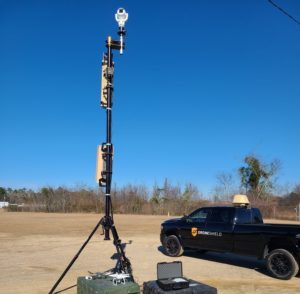

By Jim Magill
DroneShield Limited, a developer and manufacturer of counter-drone technology, said this week it has entered into a contract framework with the state of Texas that will simplify the purchase of its technology by state and local governments and educational agencies in the Lone Star State.
The contract, negotiated through the Texas Department of Information Resources (DIR) over an 18-month period, is valid for a five-year acquisition period, until February 2027. The agreement, the first of its kind for DroneShield, provides a streamlined purchasing path to any Texas agency requiring protection from the threat of rogue drones.
“It’s not the first state-level agency that we’ve been under contract with, but it is the first time we’ve been awarded with a statewide framework,” Matt McCrann, CEO of DroneShield US, said in an interview.
“We have a lot of engagement throughout the state of Texas with various organizations,” he said. In some cases, the company is just beginning to negotiate its contracts with Texas agencies.
“For others we are finalizing requirements for the organization to roll out technologies and capabilities like ours,” McCrann said.
“A contract like this gives those organizations an option and a path to procurement that’s already been negotiated and streamlined to get through the procurement hurdles that these types of initiatives sometimes get caught up in.”
DroneShield products covered under the DIR contract include eight-week threat-assessment packages for agencies that need to evaluate the quantity and types of drones operating in their area, as well as turn-key counter-drone detection, classification and tracking defeat. The company offers comprehensive counter-drone solutions, including hand-held and vehicle-mounted drone-detection devices, as well as stationary systems to provide persistent, long-range security for fixed sites.
“We provide tools for public safety, law enforcement and critical infrastructure end-users to have situational awareness around their airspace, being able to detect, track and identify drones in their immediate airspace,” McCrann said.
DroneShield’s systems deploy multiple sensors to identify and track the drones within a given airspace. “This information is tied to our command-and-control software, which is viewable at an enterprise level, an individual level, tactical or field level for situational awareness of the user,” McCrann said. “It allows the users to have the actionable determination of: is this drone a potential threat? Is it authorized to be in this space? And if not, it gives them information to be able to respond effectively.”
Unlike drone-detection technologies employed by some federal security agencies, DroneShield’s commercially available systems are based on a 100% passive response. “We do not interfere, intercept or identify any personal identification of the drone,” McCrann said.
With the growing popularity of inexpensive, easy-to-fly unmanned aircraft, the threat of drones being used for nefarious purposes also increases, he said. “Bad actors as well as good actors leverage the technology around them.”
Interest in deploying counter-drone technologies has increased in recent months, with reports of unauthorized drone sightings around high-profile events, such as NFL playoff games. “We have active engagements with stadiums, large venues and universities about the best way to utilize and deploy solutions like ours within their current capabilities,” McCrann said.
In addition to developing technology to counter unmanned aerial systems, DroneShield is also developing measures to thwart unwanted incursions by other unmanned systems, including ground-based robots and unmanned surface and underwater vessels. “We are staying ahead of the threats. As that same core technology is leveraged in different domains, the need for counter measures in those domains is increasing too,” he said.
Read more about DroneShield:
- To Catch a Drone: DroneShield, Zenith AeroTech Partner on Tethered Drone Counter UAS System
- DroneShield Snags research Deal with Homeland Security
- Counter Drone Tech Continues to Soar: DroneShield Announces New Contract, Record Results
- British Telecom Inks Deal with DroneShield to Fend Off Rogue Drones
Miriam McNabb is the Editor-in-Chief of DRONELIFE and CEO of JobForDrones, a professional drone services marketplace, and a fascinated observer of the emerging drone industry and the regulatory environment for drones. Miriam has penned over 3,000 articles focused on the commercial drone space and is an international speaker and recognized figure in the industry. Miriam has a degree from the University of Chicago and over 20 years of experience in high tech sales and marketing for new technologies.
For drone industry consulting or writing, Email Miriam.
TWITTER:@spaldingbarker
Subscribe to DroneLife here.